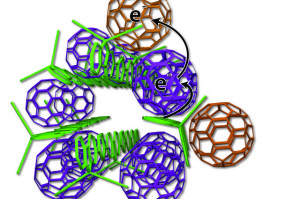
The new arrangement of photovoltaic materials includes bundles of polymer donors (green rods) and neatly organized fullerene acceptors (purple, tan).
Image: UCLA
A team of UCLA scientists are delivering good news on the solar energy front with the development of their new energy storage technology that could change the way scientists think about solar cell design.
Taking a little inspiration from the naturally occurring process of photosynthesis, the researchers devised a new arrangement of solar cell ingredients to make a more efficient cell.
“In photosynthesis, plants that are exposed to sunlight use carefully organized nanoscale structures within their cells to rapidly separate charges — pulling electrons away from the positively charged molecule that is left behind, and keeping positive and negative charges separated. That separation is the key to making the process so efficient,” said Sarah Tolbert, senior author of this research and published ECS author.
PS: Check out Tolbert’s recently published open access paper in the Journal of The Electrochemical Society entitled, “The Development of Pseudocapacitive Properties in Nanosized-MoO2.”
The currently dilemma in solar cell design revolves around developing a product that is both efficient and affordable. While conventional silicon works rather well, it is too expensive to be practical on a large scale. More engineers and researchers have been moving to replace silicon with plastic, but that leads to efficiency levels taking a hit.


